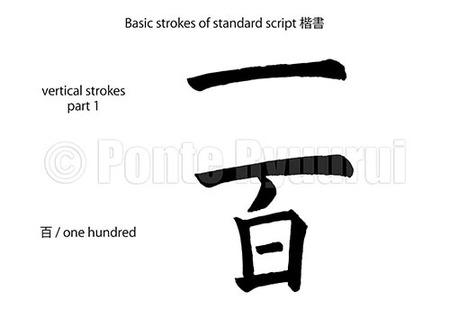 I will cover the history of the standard script (楷書) in a separate article, but for the sake of placing it on the timeline of the history of Chinese calligraphy, let me just say that its origins go back to 170 B.C, which fact was confirmed in 1972, when the unearthed bamboo slips in Hunan province (湖南) were covered in a script that displayed evident features of modern standard script. Standard script is one of the most demanding scripts in Chinese calligraphy, and also most likely the first one a new calligraphy student is about to study. There are 8 core strokes in standard script, and they are known as the 永字八法 (8 laws of the character 永). Each of those strokes has many variations. The details of the 永字八法 will be also covered in a separate article. There are many different approaches to standard script, and there are numerous classics written in various styles. Also, it is important to state that the Chinese calligraphy aesthetics and Japanese calligraphy esthetics differ. Consequently, although the rules of writing remain similar (or the same) the appearance of both may differ. Consequently, although the rules of writing remain similar (or the same) the appearance of both may vary. There are many different approaches to standard script, and there are numerous classics written in various styles. Alhough I study calligraphy in Japan, my teacher as well as the calligraphy organisations I belong to, put a very strong emphasis on Chinese classics. Therefore, my style is a blend of both types of calligraphy. Nevertheless, I decided to base my tutorials on the masterpieces of Ouyang Xun (歐陽詢, 557–641 C.E.), a brilliant Tang dynasty calligrapher, whose standard script was unmatched (although he was not the only genius of standard script in the history of China). His style may sometimes seem to be slightly over the top and "too elaborated", but the balance, character structure, and the surgical precision of strokes are simply mind blowing.
I remember I told my teacher once that I do not like a particular style of calligraphy (it was a Northern Wei standard script). He replied: "Studying only what you like is like taking a shortcut. Calligraphy is a journey. Those who are clever live by achieving an aim, and take the shortcut. Those who are wise, explore beyond their sight and become enlightened. " While studying standard script remember to: 1. write s l o w l y 2. learn the basic strokes 4. one stroke = one story 3. study different styles of standard script (do NOT copy me, copy the masterpieces) 4. never ever stop studying it, as standard script is the foundation of your skill with the brush |
Categories
All
AuthorPonte Ryuurui (品天龍涙) Archives
August 2020
|

 RSS Feed
RSS Feed
